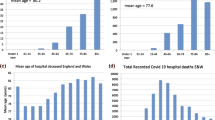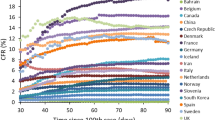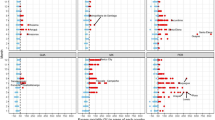Abstract
Statistical analysis of COVID-19 mortality is challenging due to its non-stationarity and cross-sectional instability. In this paper, the authors introduce a unified method to evaluate the fatality rate of COVID-19 across countries, whose method provides more reliable information for cross-country comparison than the traditional case-fatality rate (CFR). It emerges that the new method, the block-wise case-fatality rate (BCFR), varies for different countries and in different periods. The authors also decompose the COVID-19 fatality data by three factors: 1) The virus infection dynamics over population in different countries, 2) pure distribution and evolution of instantaneous death rate attributed to different individual’s physical characteristics such as age and health, and 3) individual countries’ variations affecting interactions between the virus infection and the instantaneous mortality due to individual’s physical characteristics. Based on the new three-factor model, the authors obtain six key findings of the COVID-19 fatality rate. Our study suggests that, on average, the estimated instantaneous fatality rate contributes about 57.0% to the global BCFR while the time-varying weight contributes about 41.5% in December 2020. The country-specific contribution of instantaneous fatality rate is significantly higher than that of the time-varying weight. Besides, the country-specific characteristics in demographical, social, and economic aspects would affect the relative severity of the disease.
Similar content being viewed by others
References
WHO, WHO Director-General’s opening remarks at the media briefing on COVID-19 March 11, 2020.
Jing W, Jin Z, and Zhang J, Low-dimensional sir epidemic models with demographics on heterogeneous networks, Journal of Systems Science and Complexity, 2018, 31(5): 1103–1127.
Sorci G, Faivre B, and Morand S, Explaining among-country variation in COVID-19 case fatality rate, Scientific Reports, 2020, 10(1), DOI: https://doi.org/10.1038/s41598-020-75848-2.
Fang B, Li X, Martcheva M, et al., Global stability for a heroin model with age-dependent susceptibility, Journal of Systems Science and Complexity, 2015, 28(6): 1243–1257.
Wu J T, Leung K, Bushman M, et al., Estimating clinical severity of COVID-19 from the transmission dynamics in Wuhan, China, Nat. Med., 2020, 26): 506–510.
Kayano T and Nishiura H, A comparison of case fatality risk of COVID-19 between Singapore and Japan, Journal of Clinical Medicine, 2020, 9(10): 3326.
Petersen E, Koopmans M, Go U, et al., Comparing SARS-CoV-2 with SARS-CoV and influenza pandemics, The Lancet Infectious Diseases, 2020, 20(9): e238–e244.
Yang W, Kandula S, Huynh M, et al., Estimating the infection-fatality risk of SARS-CoV-2 in New York City during the spring 2020 pandemic wave: A model-based analysis, The Lancet Infectious Diseases, 2021, 21(2): 203–212.
Nishiura H, Klinkenberg D, Roberts M, et al., Early epidemiological assessment of the virulence of emerging infectious diseases: A case study of an influenza pandemic, PLoS ONE, 2009, 4(8): e6852.
Fan G, Yang Z, Lin Q, et al., Decreased case fatality rate of COVID-19 in the second wave: A study in 53 countries or regions, Transboundary and Emerging Diseases, 2021, 68(2): 213–215.
Ghani A C, Donnelly C A, Cox D R, et al., Methods for estimating the case fatality ratio for a novel, emerging infectious disease, American Journal of Epidemiology, 2005, 162(5): 479–486.
Wilson N, Kvalsvig A, Barnard L T, et al., Case-fatality risk estimates for COVID-19 calculated by using a lag time for fatality, Emerging Infectious Diseases, 2020, 26(6): 1339.
Lipsitch M, Estimating case fatality rates of COVID-19, The Lancet Infectious Diseases, 2020, 20(7): 775.
Backer J A, Klinkenberg D, and Wallinga J, Incubation period of 2019 novel coronavirus (2019-nCoV) infections among travellers from Wuhan, China, 20–28 January 2020, Euro Surveill, 2020, 25(5): 2000062.
WHO, Report of the WHO-China Joint Mission on Coronavirus Disease 2019 (COVID-19) March 5, 2020.
Baud D, Qi X, Nielsen-Saines K, et al., Real estimates of mortality following COVID-19 infection, Lancet Infectious Diseases, 2020, 20(7), DOI: https://doi.org/10.1016/S1473-3099(20)30195-X.
Nyberg T, Twohig K A, Harris R J, et al., Risk of hospital admission for patients with SARS-CoV-2 variant B.1.1.7: Cohort analysis, British Medical Journal, 2021, 373): n1412, DOI: https://doi.org/10.1136/bmj.n1412.
Munster V J, Flagg M, Singh M, et al., Subtle differences in the pathogenicity of SARS-CoV-2 variants of concern B.1.1.7 and B.1.351 in rhesus macaques, bioRxiv [Preprint], 2021, 7(43): eabj3627.
Li J, Wu Y N, Zhang S, et al., Deep learning based on biologically interpretable genome representation predicts two types of human adaptation of SARS-CoV-2 variants, Brief Bioinform, 2022, 23(3): bbac036.
Author information
Authors and Affiliations
Corresponding author
Ethics declarations
The authors declare no conflict of interest.
Additional information
This study was supported by the National Key R&D Program of China under Grant No. 2021ZD0111204 and the National Natural Science Foundation of China under Grant Nos. 72073127 and 71988101.
Rights and permissions
About this article
Cite this article
Cheng, B., Bao, Q., Zheng, Y. et al. How to Estimate the Mortality Risk of COVID-19: A New Approach with a Three-Factor Decomposition. J Syst Sci Complex 36, 1658–1679 (2023). https://doi.org/10.1007/s11424-023-1214-0
Received:
Revised:
Published:
Issue Date:
DOI: https://doi.org/10.1007/s11424-023-1214-0




